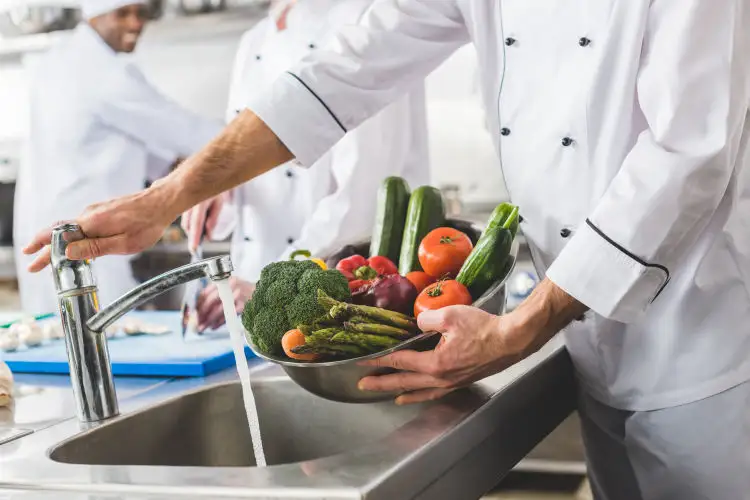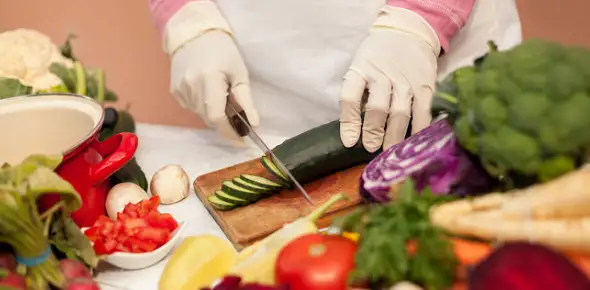In the catering industry, ensuring food safety is paramount. Catering services provide meals and beverages for various events, but neglecting proper food safety protocols explained can lead to potential health hazards. This article aims to delve into the intricacies of food safety protocols and examine the health risks associated with catering services.
Implementing effective protocols is crucial to serving safe and uncontaminated food. From handling and storing ingredients correctly to maintaining hygiene in the preparation area, catering services must adhere to stringent guidelines to protect the health of their clients.
It is also vital to identify and address specific health hazards, including cross-contamination, improper temperature control, and inadequate hygiene practices. By understanding these risks, we can mitigate them and ensure the safety of both catering staff and consumers.
Key Takeaways
- Food safety protocols in catering services involve handling and storing ingredients correctly, maintaining hygiene in the preparation area, and adhering to stringent guidelines to protect the health of clients and prevent cross-contamination.
- Health hazards in catering services include foodborne illnesses due to incorrect temperature storage, cross-contamination from raw to ready-to-eat foods, spread of harmful bacteria from inadequate cleaning and sanitization, and serious health risks from improper handling of allergens.
- Hygiene practices in catering include regular handwashing, proper cleaning and sanitization of equipment and utensils, appropriate food storage and handling practices, and maintaining high standards of personal hygiene to prevent the spread of foodborne illnesses.
- Temperature control is crucial in food safety, with the temperature danger zone between 40°F (4°C) and 140°F (60°C). It is important to keep hot foods above 140°F (60°C) and cold foods below 40°F (4°C), use proper cooking temperatures to kill harmful bacteria, and monitor internal temperature with a food thermometer to reduce the risk of foodborne illnesses.
Importance of Food Safety Protocols
Food safety protocols are of utmost importance in the catering industry. In order to ensure the health and well-being of customers, it is essential that catering establishments follow strict guidelines and procedures when handling and preparing food. These protocols are designed to prevent foodborne illnesses and to maintain the highest standards of hygiene.
One of the main reasons why food safety protocols are crucial in the catering industry is the potential for cross-contamination. With the handling of various ingredients and the preparation of different dishes, there is a risk of harmful bacteria or allergens being transferred from one food item to another. By implementing proper protocols such as frequent handwashing, separate cutting boards for different types of food, and regular sanitization of equipment and surfaces, catering establishments can minimize the risk of cross-contamination and ensure the safety of their customers.
Furthermore, food safety protocols also play a vital role in preventing the growth of bacteria and other pathogens in food. Proper storage, temperature control, and cooking techniques are essential to kill harmful bacteria and ensure that food is safe for consumption. Regular monitoring and documentation of these procedures are necessary to maintain accountability and track any potential issues.
Common Health Hazards in Catering Services
Numerous health hazards can arise in catering services due to improper handling and storage of ingredients, inadequate sanitation practices, and lack of temperature control.
One of the common health hazards in catering services is foodborne illnesses. These can occur when food is not stored at the correct temperature, allowing bacteria to multiply and contaminate the food.
Cross-contamination is another potential hazard, where pathogens from raw food can be transferred to ready-to-eat foods.
Inadequate cleaning and sanitization of utensils, surfaces, and equipment can also lead to the spread of harmful bacteria.
Furthermore, improper handling of allergens can pose a serious health risk to individuals with allergies.
It is crucial for catering services to implement proper food safety protocols, including training staff on proper hygiene practices, maintaining appropriate temperature control, and ensuring proper storage and handling of ingredients to minimize these health hazards.

Understanding Food Contamination Risks
To further delve into the risks associated with catering services, it is important to gain a comprehensive understanding of the various factors that contribute to food contamination. Food contamination can occur due to a variety of reasons, including:
- Poor personal hygiene: Improper handwashing or wearing contaminated clothing can introduce harmful bacteria to the food.
- Cross-contamination: When raw and cooked food come into contact with each other or with contaminated surfaces, it can lead to the spread of bacteria or pathogens.
- Inadequate storage: Improper temperature control or storing food in unclean areas can promote the growth of bacteria.
- Improper cooking temperatures: Undercooking food can leave harmful bacteria intact, while overcooking can lead to the formation of toxins.
It is crucial for catering services to implement strict food safety protocols to mitigate these contamination risks and ensure the health and well-being of their customers.
Role of Proper Hygiene Practices in Catering
Proper hygiene practices play a crucial role in ensuring the safety and quality of catering services. Maintaining high standards of hygiene is essential to prevent the spread of foodborne illnesses and to protect the health of customers. When it comes to catering, there are several key areas where proper hygiene practices must be followed.
Firstly, personal hygiene is of utmost importance. Catering staff should regularly wash their hands with soap and warm water to prevent the transfer of bacteria and other contaminants. They should also wear clean uniforms and hairnets to minimize the risk of contamination.
Secondly, equipment and utensils used in catering should be properly cleaned and sanitized. This includes cutting boards, knives, and food preparation surfaces. Regular cleaning and disinfection help eliminate bacteria and prevent cross-contamination.
Lastly, proper food storage and handling practices are essential. Food should be stored at appropriate temperatures to prevent bacterial growth. Additionally, separate storage areas should be designated for raw and cooked foods to prevent cross-contamination.
The Impact of Temperature Control on Food Safety
Temperature control plays a critical role in ensuring the safety and quality of food in catering services. Maintaining the proper temperature at different stages, from food preparation to storage and transportation, is essential to prevent the growth of harmful bacteria and reduce the risk of foodborne illnesses.
Here are two key points to consider regarding the impact of temperature control on food safety:
- Temperature Danger Zone: The temperature danger zone refers to the range of temperatures between 40°F (4°C) and 140°F (60°C). Within this range, bacteria multiply rapidly, increasing the risk of food contamination. It is crucial to keep hot foods above 140°F (60°C) and cold foods below 40°F (4°C) to prevent bacterial growth and maintain food safety.
- Proper Cooking Temperatures: Cooking food at the correct temperature is vital to kill harmful bacteria and ensure food safety. Different types of food require specific internal temperatures to be reached to eliminate pathogens effectively. Using a food thermometer can help monitor the internal temperature and ensure that foods are cooked thoroughly.
Best Practices for Implementing Food Safety Protocols in Catering Services
Implementing effective food safety protocols is crucial for ensuring the health and well-being of customers in catering services. To achieve this, catering businesses should follow best practices that prioritize cleanliness, hygiene, and proper handling of food.
First and foremost, it is essential to maintain a clean and sanitized kitchen environment. Regular cleaning of surfaces, utensils, and equipment is necessary to prevent cross-contamination and the growth of harmful bacteria.
Additionally, all staff members should receive comprehensive training on food safety procedures, including proper handwashing, wearing gloves, and using thermometers to check food temperatures.
It is also important to establish a system for monitoring and documenting food safety practices, such as conducting regular inspections and keeping accurate records.
Frequently Asked Questions
How Can Food Safety Protocols Help Prevent Health Hazards in Catering Services?
Food safety protocols in catering services play a crucial role in preventing health hazards. By implementing strict hygiene practices, regular sanitization, proper food handling, and temperature control, these protocols ensure the safety and well-being of customers.
What Are Some Common Health Hazards That Can Occur in Catering Services?
Common health hazards that can occur in catering services include food contamination, improper food handling and storage, cross-contamination, inadequate temperature control, and poor hygiene practices. These hazards can lead to foodborne illnesses and pose a risk to the health and safety of consumers.
How Does Understanding Food Contamination Risks Contribute to Maintaining Food Safety in Catering?
Understanding food contamination risks is crucial for maintaining food safety in catering. It allows caterers to identify potential hazards, implement preventive measures, and ensure proper handling, storage, and preparation of food, minimizing the risk of foodborne illnesses and protecting the health of consumers.
What Role Do Proper Hygiene Practices Play in Ensuring Food Safety in Catering Services?
Proper hygiene practices play a crucial role in ensuring food safety in catering services. By maintaining cleanliness, such as regular handwashing and sanitization of equipment, the risk of foodborne illnesses and contamination can be significantly reduced.
Why Is Temperature Control Important for Maintaining Food Safety in Catering?
Temperature control is crucial for maintaining food safety in catering. Proper temperature control ensures that perishable foods are stored and cooked at safe temperatures, preventing the growth of harmful bacteria and reducing the risk of foodborne illnesses.
Conclusion
In conclusion, food safety protocols are crucial in the catering industry to protect the health of customers. By understanding and implementing these protocols, catering services can ensure that the food served is safe and free from contamination.
It is important to address the various health hazards that can arise in catering services, such as cross-contamination and inadequate hygiene practices. By following best practices and maintaining proper temperature control, catering services can mitigate these risks and promote food safety.
You may also like to read:
Scientific Health Benefits of Moringa Powder








